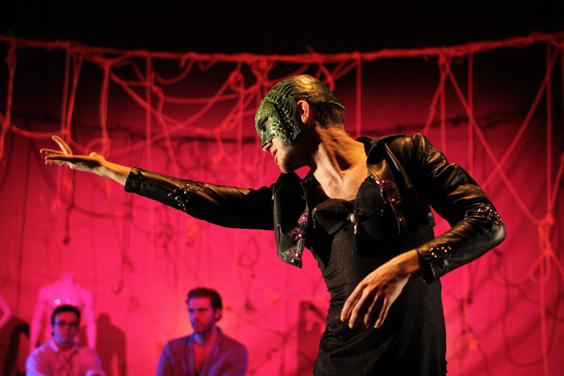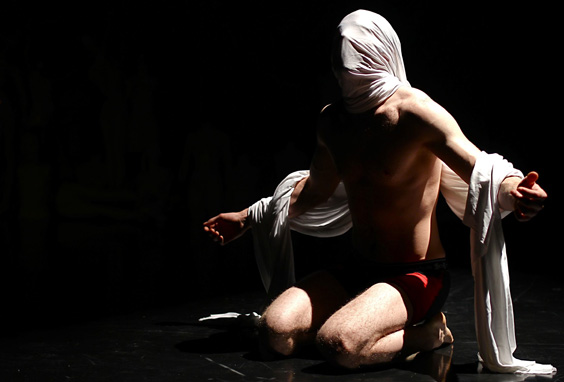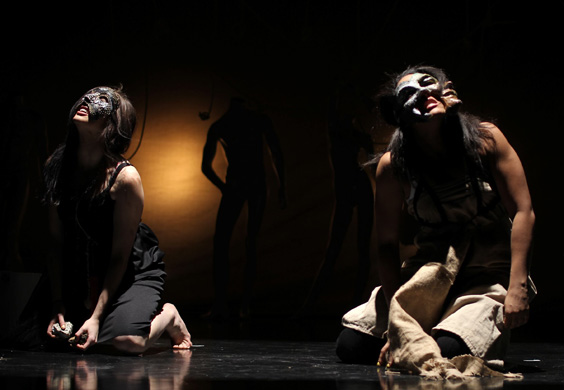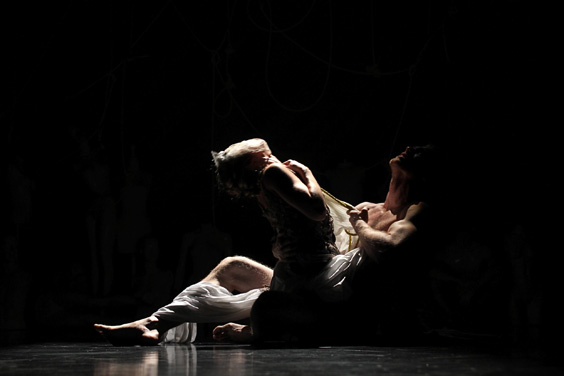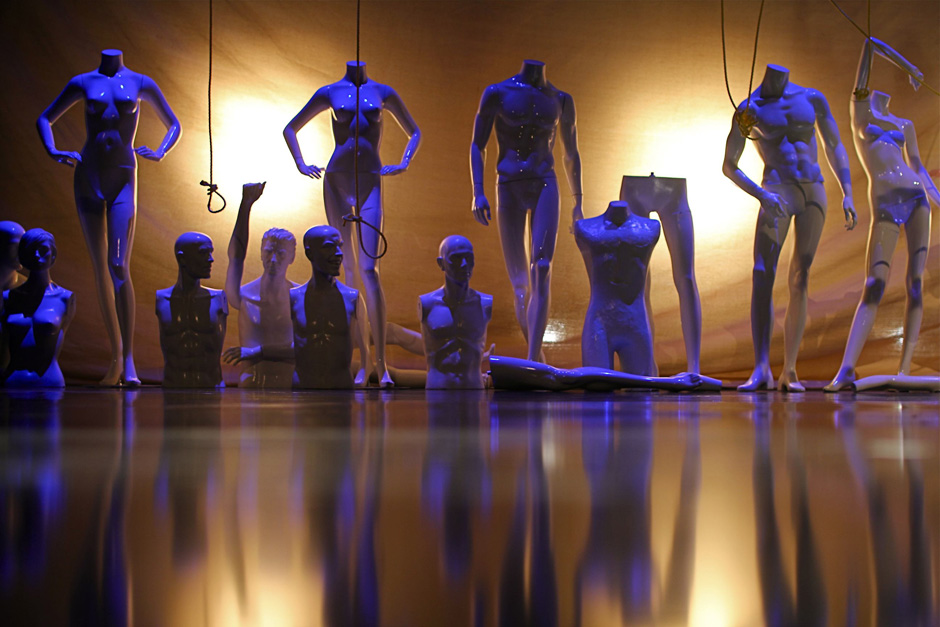SYMPATHY FOR THE DEVIL
SYMPATHY FOR THE DEVIL
Shayne Gryn talks to the folks behind the local theatre production of Clive Barker’s THE HISTORY OF THE DEVIL
———————–
The discount viagra cialis levitra online Devil has been a subject of fascination for countless authors, especially in the horror genre, as he has earned the reputation of being the personification of all that is evil. Whether portrayed as charismatic or conniving, the generic viagra online uk Great Deceiver is rarely treated with courtesy, sympathy, or taste. One exception to this frequent portrayal is Clive Barker’s The History of The Devil, which was recently mounted (with support from Barker’s camp, who are also mounting the show in L.A.) by the young Montreal theatre company Title 66 Productions at Theatre Rouge.
The show, directed by Jeremy Michael Segal and featuring Lucas Chartier-Dessert in the title role, broke many conventions of both buying generic cialis mexico rx theatre and morality. Before the show begins the lighting grid hangs within reach soft viagra of a ladder that is on stage. A stage hand removes a gel and puts the ladder away backstage. This, along with visible wings, serve to remind viewers that we are watching a play, intentionally spoiling the illusion of theatre. Viewers have the impression that they are about to view a surreal, nonsensical, exaggeratedly dadaist play, but the buffoonery soon gives way to a clear and relatable linear narrative. Lucifer is put on trial and is vying for readmittance to Heaven, from which he was once banished as an Angel, and each witness called shows us a glimpse of his past living amongst humans for 3000 years. This format allows the cast of 8 to portray a total of 34 characters in a way that is remarkably easy to follow.
The vignettes showcase events in Lucifer’s life that any moral-absolutist would characterize as evil (including the rape and killing of a mentally disabled girl, and the callous disassembling of a sentient automaton that he’d created) and then shows us either the justification or decidedly human reasoning for his actions. Some scenes depict the humans with which he interacts as less morally grounded or even more demonic than himself. This serves to raise the question of whether the Devil is truly evil, or simply the greatest scapegoat in human history.
Segal and Chartier-Dessert, along with cast member Liana Montoro took the time to talk with Spectacular Optical about their experiences working on the piece.
Spectacular Optical: Clive Barker is highly regarded as an author and an important figure to fans of horror films, but he is not widely known as a playwright. What led you to putting on this piece?
Jeremy Michael Segal: I have been a great fan of Clive Barker’s novels for some years now, and I happened upon his book of 3 plays called Incarnations in a second-hand book store. I never knew that he wrote plays so I was absolutely ecstatic to find it. The timing of it was great. We were preparing for our post-mortem meeting for, Title 66′ first show, Chekhov’s Children and it was at that meeting that we were to decide what our next project would be. I read the three plays that make up Incarnations and The History of the Devil instantly struck me as such a living piece of art. I knew right away that I wanted to explore it.
SO: I got the impression that Title 66 is a very collaborative company. What inspired you all to take on a piece that is challenging on so many levels?
JMS: Yes, we are by nature a very collaborative company. As the director, I certainly had a clear vision as to what I wanted the show to be, but ideas and interpretation were always an open channel with the cast and crew.
Liana Montoro: Jeremy’s vision was very clear at the beginning of the process. I was not at all familiar with History of the Devil at first and knew that it was a very challenging piece to put together. However, we were given a chance to try different things.
SO: Given the iconic status of the character being portrayed in the title role, was it difficult to not be overly influenced by previous portrayals of the Devil or were there direct influences that you intentionally drew from?
Lucas Chartier-Dessert: I actually avoided at all cost any movies or plays or books with any interpretations of the devil in it, because I feel that in this play especially, the Devil absolutely needs to seem like a human, and as I am a human, I wanted everything that was the devil to come from me, and my own mind.
JMS: The point of the play is that we treat the Devil as a scapegoat. So, considering that, any literature or movies Lucas may have watched would have led him exactly to the stereotypical place where humanity wants the devil to be.
SO: Some of the subject matter in the piece was very heavy. Was there a lot of discussion as to how to present or contextualize some of the more shocking moments of the play, so that it wouldn’t be treated lightly? And to that extent, were any of the cast uncomfortable with some of the subject matter?
LM: We discussed the various themes and subject matter before even getting on our feet. We all wanted to share our research on the different historical events and characters. Through explorations and discussion I think it helped us establish the intensity of this play. I don’t think the subject matter made me uncomfortable. It was just really overwhelming at first to take it all in, but the more rehearsed questions were answered.
JMS: I didn’t even think of it as a problem. Clive Barker wrote it all in because it is necessary to the story that he wants to tell. I tried my best to find the truth of each scene. I think that if you tell the truth, people will relate to it instead of being offended by it. Ultimately, each situation is about being a human being and all the suffering and hardships that we can all relate to.
JCD: At the first reading of the play, I have to admit I was a bit worried as to what it would be like to perform the first scene big scene with the disabled girl. I think the key to overcoming insecurities and making sure the message is conveyed in a tasteful and effective manner is just committing to that moment and playing the absolute truth, as well as having a a great director to guide you through it.
SO: That was one of several scenes that some viewers might have found harrowing, but in the end, The Devil is portrayed as sympathetic and the girl’s mother is shown to have questionable morals. One other scene I noticed that could have been played up for shock value was the Devil’s casual racism towards Mary-Ann Clarke, but the moment was entirely understated and not emphasized. What played into that interpretation?
LM: In the Jack Easter scene, the Devil meets her for the first time. She’s a famous actress and he mentions how he loves her Desdemona. He says “I never hated the nigger so much in my life”. He’s referring to Othello. Jeremy had the idea that since we were working a lot with actors in and out of characters, when he says “nigger”, I [am] taken by this because it’s a racist comment to me not to Mary Anne Clarke. It’s one of the several moments where we actors break character.
JMS: A large influence for Title 66 is Bertolt Brecht. His theories of Theatre distance the audience from the action so as to judge the situation rather than simply feel and forget. We applied his theory to this moment by having Liana take off her mask and acknowledge that she is black. By acknowledging the moment, I think we took away a lot of the possible resentment, while leaving room for the audience to make their own decision as to how they feel about the Devil saying that.
LCD: The way I saw it and I think Jeremy and Liana would agree, is that if we were actually in 1799, then the word ‘nigger’ would not be offensive at all, so we just wanted to it to be a casual everyday sounding thing, to show the Devil adapting to any time period he is in at the moment.
LM: Yes agreed. It was another moment that shows the Devil travelling through different time periods.
SO: The piece wasn’t just difficult in terms of the subject matter, but also the presentation. It breaks a lot of conventions of theatre in a decidedly post-modernist way that constantly reminds you that you’re watching a play. Was there any fear that it would be difficult to engage the audience in a believable way when they are constantly reminded of this?
LM: As an actor it was very challenging to break character, especially when we’re use to sustaining a character for the length of a play. Yet, when we actually had an audience it was exhilarating to move from one character to the other. It’s as though the fear we have as actors not to forget lines not to break character was forgotten in this show. It gave us all a chance to really live in the moment as we should.
JMS: The Brechtian style actually became more and more prevalent as the play went on. My concept for the show is the shedding of layers. The set disappears, the costumes get more and more simple, we end with the house lights up, the sound cues give way to actors’ vocalizations. Part of the shedding of layers was the acting style itself beginning as almost farcical in the first scene, with the laugh tracks, and ending in a very Brechtian style. The aim of all this was to bring the audience on the Devil’s journey. The show becomes more and more human as it goes on, just as the Devil’s humanity is shown more and more in each episode.
SO: In spite of distancing the audience, by the end of the play audiences have developed a real bond with the Devil and are sympathetic to him. Did you find the text treats him in such a way, or is this more something that developed in rehearsals?
JMS: The text definitely treats him that way. Judge Felix Popper, in his closing statement, says, “I would have liked a little less humanity in him.” He is shown more and more as the story is told to be humanistic. It was a choice, however, to make the Devil end up more human than even the humans around him. I think that was an important choice in our interpretation. One of the points of the play is that humanity is as bad as they make the Devil out to be. By revealing the Devil as the definition of what we call ‘human,’ where does that leave us?
LCD: The text does make the devil look more and more human as the play goes on, but it was mostly Jeremy wanting the audience members to really feel bad for him in the end, and to try to feel some sympathy for him.
LM: This was a strong choice Jeremy had from the beginning – in the end to make us sympathize the Devil rather than fear him.
JMS: Yes, we definitely explored new territories of artistic expression. I also thought it was important towards the beginning of the story, when we first meet the Devil, to show the audience his supernatural powers so that by the end, when he’s stripped of everything but his dreams of paradise, we see his journey very clearly.
——————-
Photos courtesy of Julia Milz

 April 1, 2012
April 1, 2012  No Comments
No Comments
